My buddy Kris and I arrived in Cusco, Peru a few weeks ago with the intention of visiting Machu Picchu, but we had no tickets and no plans. Our lack of preparation could have been a disaster but lucky for us it turned into one of the most epic adventures we've ever had riding motorcycles through mountains as high as 4300 meters (14,000 feet) in elevation, into rivers that flowed as high as our knees, and down undiscovered dirt roads with views that could only be described by Kris as, “I thought I'd only see things like this in my life on TV.”
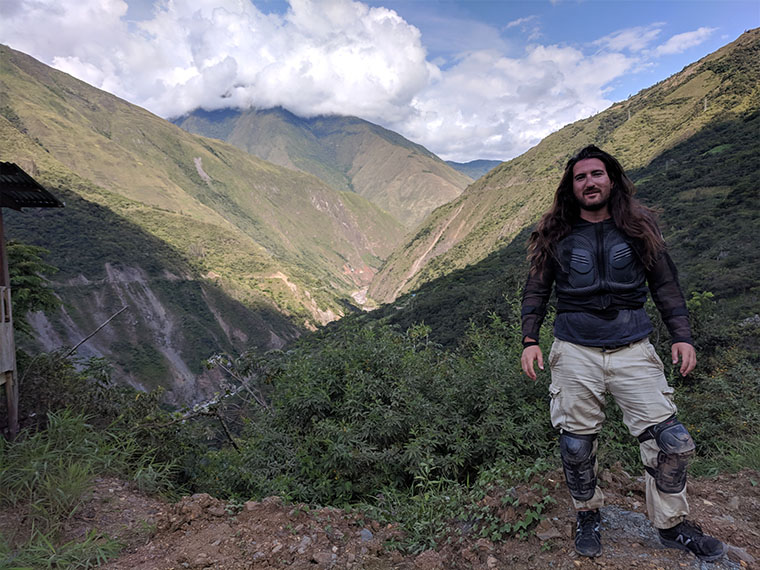
As you might know, the train tickets to Machu Picchu are crazy expensive and the affordable ones sell out quick. On a Monday evening in Cusco, Kris and I were perusing the different train companies' websites and the only tickets we could find available for that week exceeded $200 each-way and were for times of day that would require us to stay an extra night in Aguas Calientes – which Kris did not have time for. Let me backtrack for one second…
Cusco is the hub city in Peru of which everyone who goes to Machu Picchu passses through. It's a city of about 500,000 Peruvians which sees over 4 million visitors a year. Kris and I started our journey by taking an hour flight from Lima to Cusco and moving into an Airbnb in Wanchaq, an area of Cusco slightly outside of the main tourist area in Centro Historico.
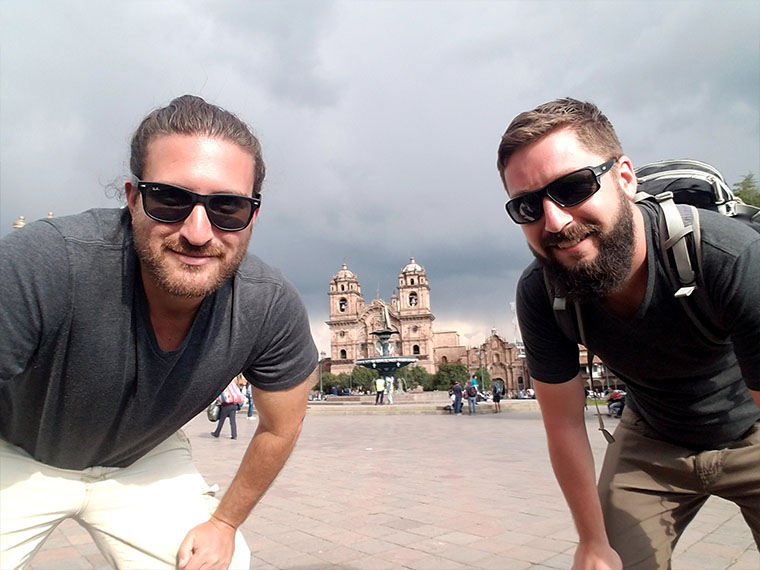
However, Machu Picchu isn't actually in Cusco – it's in a town called Aguas Calientes nestled in the mountains a few hours away, and it's impossible to reach Aguas Calientes by car because no roads extend as far as this town… only train tracks do.
How To Get To Machu Picchu from Cusco By Train
Therefore, the easiest and most popular way, albeit most expensive way, to reach Aguas Calientes is by train via one of the two train companies that operate from Cusco which are Peru Rail and Inca Rail. The tickets range in price from $65 to $250 each way for the 3 1/2 hour, 112 kilometer (70 mile) ride – making it the most expensive fucking train ride in the world! (Okay, not really the most expensive train ride in the world, but it certainly feels like it when you're about to shell out almost $500 for a roundtrip ticket.)
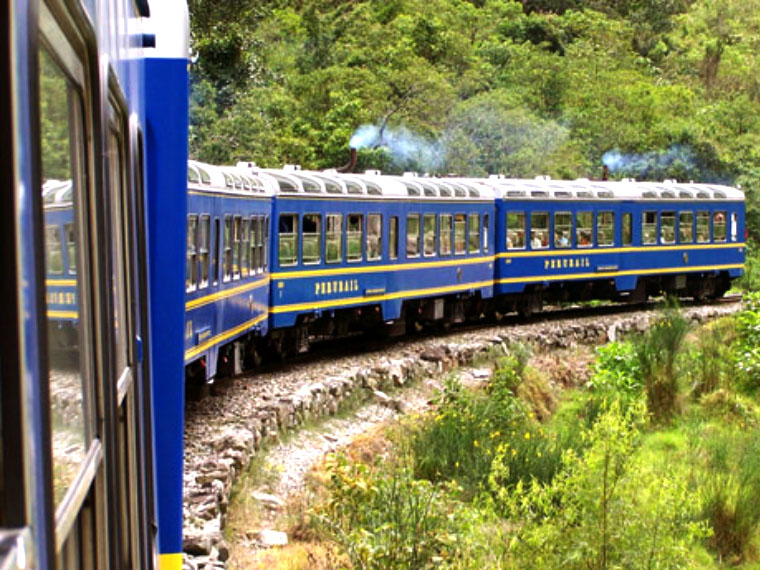
I'm not going to go into the details about how to get to Aguas Calientes by train because there's more than enough information about it available online. Kris and I had a budget for this trip, and taking the train would've greatly exceeded it, so we had to either find an alternative solution to get to Machu Picchu or scrap the idea. These are the alternatives we considered…
Alternative #1: Cusco to Machu Picchu by Bus
Wait a minute, I thought you just said that no roads extended as far as Machu Picchu?
That's right – hold your horses! There's a place called Hydroelectrica which is a hydroelectric power plant that provides electricity to most of the area, and this is where the road ends. It's about 11 kilometers from Aguas Calientes, and so a few years ago budget backpackers started chartering vans here, and then hiking the remaining 11km along the train tracks to Aguas Calientes.
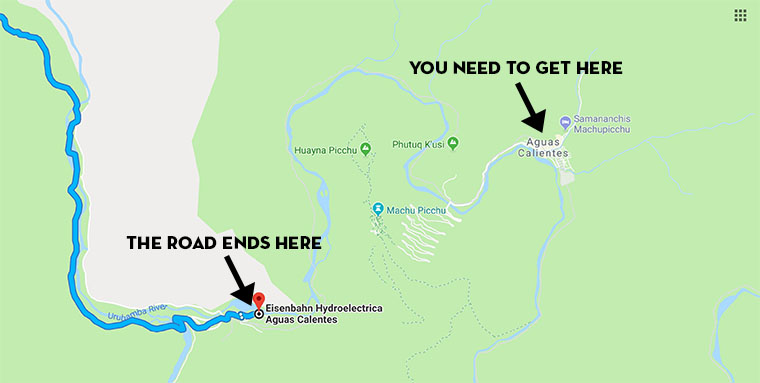
At this point, thousands of travelers take this route every year and there are more than plenty of buses and vans that will take you from Cusco to Hydroelectrica for about $25 each way – or even less than that if you book with a group. And when you return in the other direction, there are more than enough vans and buses waiting to sell you a ride back, or you can have one pre scheduled with the company you initially book with.
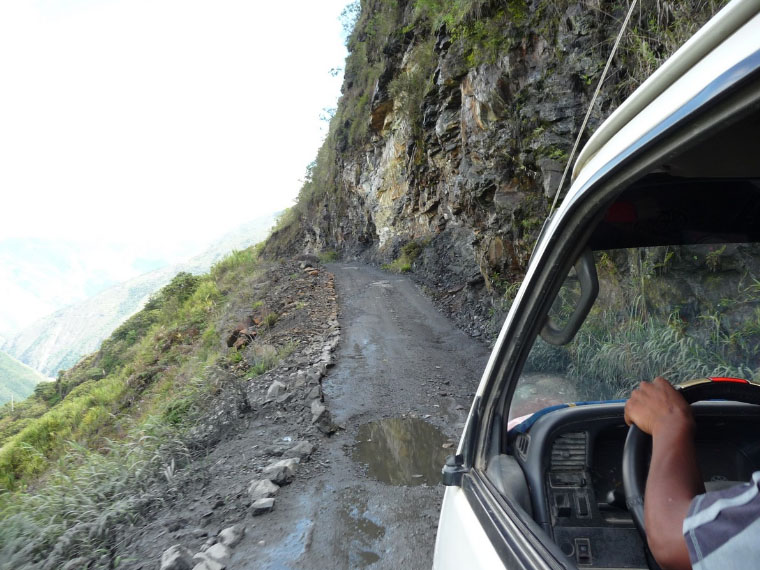
This is the most economical way to get from Cusco to Machu Picchu, and one that Kris and I were considering because it was both affordable and readily available without having to book tickets in advance. Companies that operate buses and vans to Hydroelectrica will sell you a ticket on the same morning you'd like to go, but it's probably best to book a few days in advance to be on the safe side. At the time, this was our most reasonable and affordable option.
Alternative #2: Hike from Cusco to Machu Picchu
As I mentioned earlier, it's only 112 kilometers (70 miles) if we were to follow the train tracks all the way from Cusco to Aguas Calientes, and either of us could do a hike like that, although spaced out over 2-3 days.
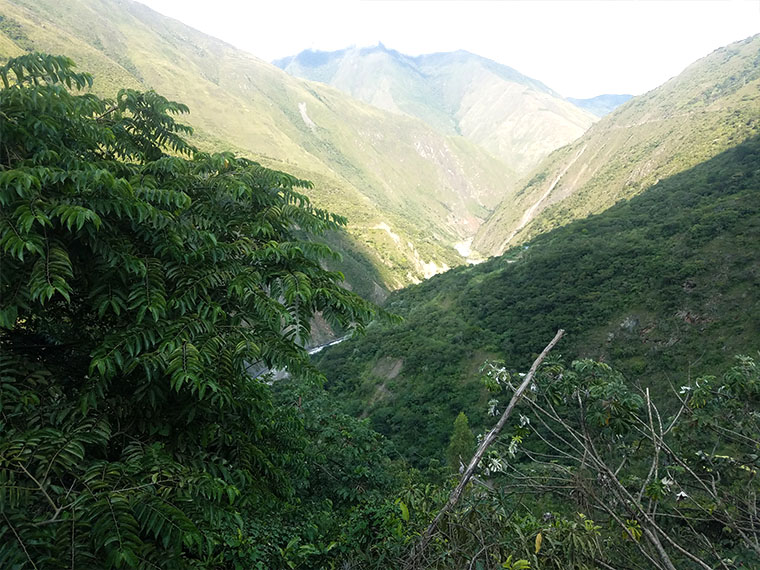
Ultimately we vetoed this idea for three reasons:
- Lack of time. Kris only had a week's vacation and we had 3 days to get from Cusco to Aguas Calientes, visit Machu Picchu, and return to Cusco before his flight back to Lima the following morning.
- No preparation. Neither of us had any camping or hiking gear.
- Altitude adjustment. Hiking 70 miles in North Carolina where we're from is a lot different than hiking the same distance around Cusco which exceeds 4,300 meters (14,000 feet) in elevation at times. The two of us were huffing and puffing through the streets of Cusco the first couple days because we hadn't had time to adapt to the elevation yet. We're both in decent shape and are active hikers, but we weren't about to attempt a 70 mile hike at this elevation without preparation and spending a few days adjusting to the elevation.
Alternative #3: Helicopter from Cusco to Machu Picchu

This option didn't turn out to be real. It was just an idea we thought of during dinner. But even if it was real, it'd probably be more expensive than taking the train anyway!
Alternative #4: Ride Motorcycles from Cusco to Machu Picchu
This was the other idea we had during dinner – after helicopter – and one which we didn't know was possible at the time. The idea was to ride motorcycles to Hydroelectrica and hike the rest of the way along the train tracks – which is exactly what we ended up doing.
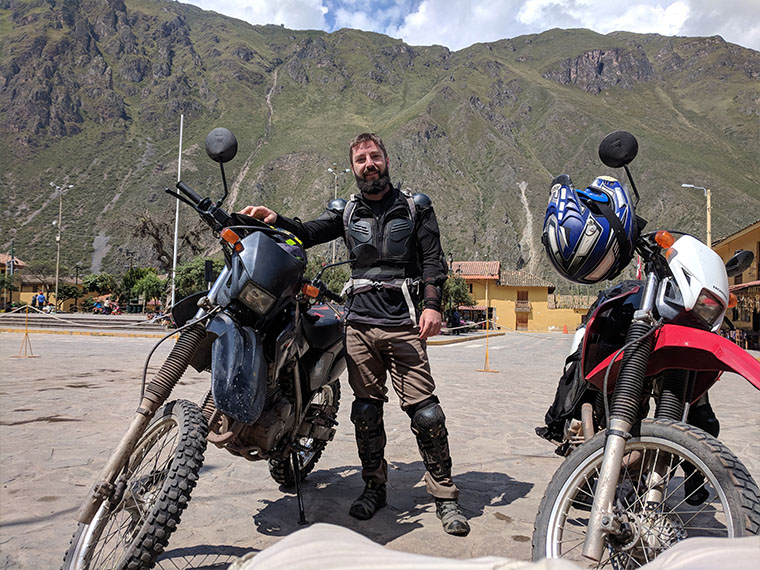
Our Internet research got us nowhere and we had to piece together outdated information from various websites as well as talk to locals and tour companies to get all the facts. And that's why I decided to write this guide today because I want to make your life easier going on one of the most epic adventures of your life. If Kris and I had the information I've prepared for you in this guide while we were in Cusco, it would've saved us about half a day of research, making plans, and preparing for the unknown.
How To Get From Cusco to Machu Picchu by Motorcycle
Before I get into the specific steps and directions, let me first talk to you about the ride itself.
Experience Required: If motorcycling experience was ranked on a scale of 1 to 10, you're going to need at least a 4 but ideally a 6 or higher. This is a CHALLENGING ride! We climbed mountains with more than 25 switchbacks which offered zero guard rail protection against giant tour buses that sped past us. We crossed rivers on our bikes – well more accurately the SAME river 10+ times as we ascended and descended one particular mountain – where sometimes the water went as high as our knees on the motorbikes. During the 8 hour ride, the temperature changed from t-shirt weather and sunny skies to heavy jacket weather (which we didn't have) as we ascended one mountain and rode through the frigid cold. We rode through miles and miles of single lane dirt roads, and at one point, the road just stopped because it was being rebuilt and was under construction, so we had to ride through a few hundred meters of mud.
All and all this was a DANGEROUS fucking ride at times! The ride there was completely smooth sailing for both of us, but on the way back, I ran into a major issue. It had rained the night before and so the dirt road from Santa Teresa to the paved road was straight mud in some areas. I lost control of my bike and crashed it into a giant boulder so hard that I bent the gear shifter. We were in the MIDDLE OF NOWHERE without a town in site for several kilometers, and my bike was stuck in 1st gear. I had to ride my bike back to the nearest town in 1st gear the entire time until I could find a mechanic who could use his tools to bend my gear shift back into position. And since I couldn't get out of 1st gear, I must've flipped my bike at least 5 more times along the way because I couldn't properly accelerate around curves. Once I got my bike fixed though in the nearest town over, it was smooth sailing again from there.
This is definitely not a ride for a brand new inexperienced rider. If you've only pranced around Bali or Chiang Mai on your little scooter and think you're experienced enough to properly do this ride – you've got another thing coming. That being said, if you've got basic experience in both city riding, dirt biking, and/or off road biking, then you can definitely do this route and it'll be one of the best rides of your life.
And now that I've cautioned you with my tale, here are the step by step directions that Kris and I wish we had known before we began our journey.
Step 1: Rent motorcycles in Cusco
The company to use is called Engine Mototours Peru and the owner's name is Juan Carlos. You can reach him on WhatsApp at +51-973-558-917 or via his website or Facebook page. His office his located at Urb. Centro Historico Calle Plateros No 373-A Cusco which is about a 2 minute walk down a side street from Plaza De Armas in Centro Historico.

It's located right across from Fuego Burgers & Barbecue restaurant which is where I filmed my video on alpacas.
We rented Honda Tornado 250 CC bikes for three days for a total of $100 which included a helmet, gloves, knee pads, and vest. The cash deposit was $150 per bike, or we could've opted for leaving no deposit if we left our passports instead. However I carry my passport with me 100% of the time in foreign countries and I recommend that you do the same – so leaving it there wasn't an option for me and I chose to pay the cash deposit because in the event of a problem, frankly I'd rather lose $150 than have any issue getting my passport back. (Remember, Juan Carlos and his company were strangers to me at the time.)
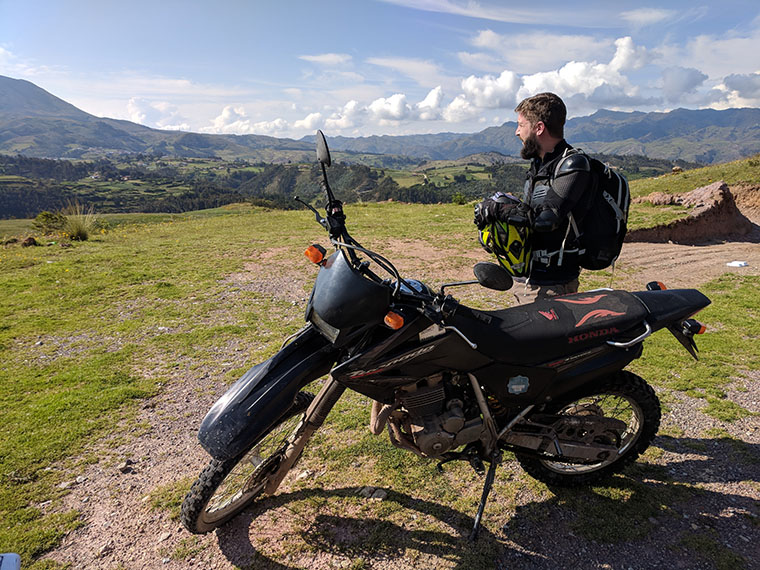
We rented the bikes for Wednesday morning through Friday evening. We paid the $100 on Tuesday afternoon to reserve the bikes and then brought the cash deposits the next morning when we picked up our bikes at 7am.
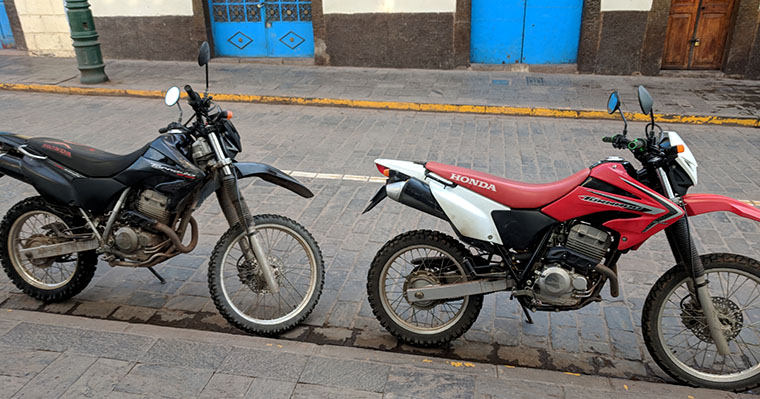
Now that I've done business with Juan Carolos, I recommend Engine Mototours Peru for four reasons:
- Juan Carlos takes care of his bikes. He regularly maintains them, tunes them up, and tests them before and after each rental. The Honda Tornado 250 CC bikes we rented were in great shape.
- He's trustworthy. After all, we had to put down a cash deposit for these bikes, so it's important to do business with someone you trust because I wanted that deposit back without issue! Of course, trust is earned and I took a leap of faith doing business with this company, but now you can take my recommendation and won't have to take a leap of faith of your own.
- He's not going to rip you off. And the unfortunate reason I know this is because I FUCKED UP my bike! I mean, it could've been worse, but when I took that spill on the dirt road, I broke both mirrors, one blinker light, and scuffed up the front bumper. He could have made up prices and kept my entire deposit if he wanted and I would've been none the wiser, but instead he pulled out a price sheet from a local mechanic, went through each item of damage line by line, and charged me accordingly. Overall I paid $90 for the damage I caused to the bike, which I thought was extremely fair. At no point in the process did I feel like I had to negotiate him down because he wasn't trying to take advantage of me – and I also wanted to rightfully pay for the damage I had caused.
- He's a nice guy. When I came back and my bike was noticeably damaged, Juan Carlos's first question was, “Are you okay?” The condition of his bike was of second importance to my well being.
- I'd pack warmer clothes. One of the most dangerous scenarios a motorcycle rider can experience is being chilled to the bone, and that's exactly how we felt on that one stretch of mountain because we did not have the proper gear to keep us warm. An extra sweater at minimum would've been fine, but all I had was a fleece and a windbreaker. (I travel light and usually to warm destinations so I don't have too much winter gear.)
- I'd do the trip over 5 days instead of 3 days. It would have been nice to spread the motorcycle ride out in each direction over two days and spend time in places like Ollantaytambo and Pisac. It's also best when riding a motorcycle to take consistent breaks along the way, but Kris and I were pushed for time the entire ride so we didn't stop as much as I would have normally liked – which is also why I don't have as many photos along the way as I would've normally taken. We had to push it to make all this happen in 3 days. “I wish I had more time.” Isn't that the story of every vacation and also life?
- I'd buy my tickets to Machu Picchu + Huayna Picchu in advance. It would've been fun to do both, but buying things in advance isn't normally part of my lifestyle because my trips are often planned with short notice, including this one with Kris.
Step 2: Fill up at the nearest gas station
A full tank of gas will get you all the way to Hydroelectrica, your final destination. However, just to be on the safe side, we put a few dollars worth of gas in the tank in Santa Teresa too. Better safe than sorry. Just be sure to leave Cusco with a full tank as depending on which route you take, you might go for a stretch without gas stations.
Step 3: Choose your route: Pisac or Chinchero District
When you leave Cusco, you can either go northeast towards Chinchero District (but not actually through it unless you want to) or northwest towards Pisac, after which you're going to eventually end up in the same place in Uramba and head towards Ollantaytambo. There's only about an 32 km difference between the two routes so you're probably going to want to do both – one in each direction – like we did.
ROUTE #1: The northeast route towards Chinchero District is shorter in distance, but more challenging and I think more fun. You ascend and then rapidly descend a mountain just as you're hitting Urubamba which reveals one of the most beautiful views I've ever seen.
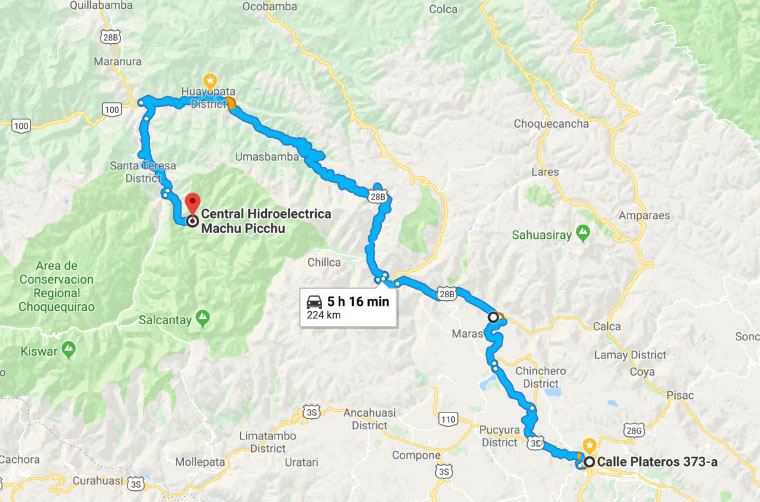
The route through Pisac is longer by 32 km but Pisac is a popular tourist destination to pass through and it doesn't take much more time because the route is easier. We took this route on the way back.
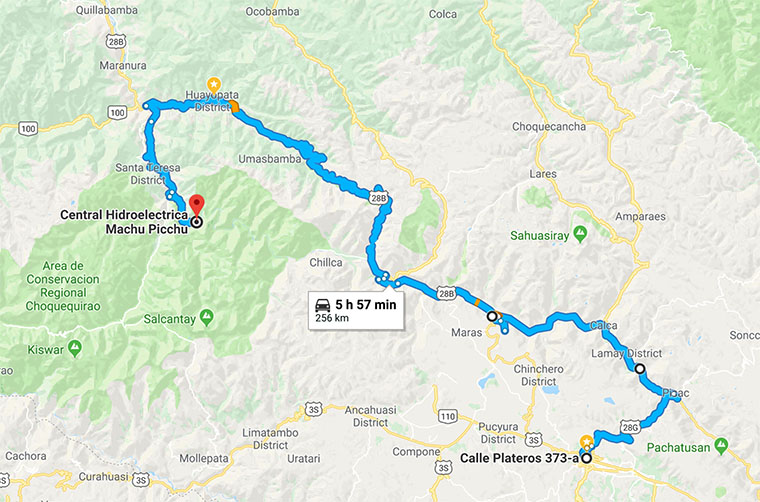
Step 4: Urubamba to Santa Teresa
Whichever route you decide to go, you're eventually going to make it to the town of Urubamba. From there you'll continue towards Ollantaytambo which is a fun section because the roads really open up for a bit and you can catch some speed on your bikes.
Ollantaytambo is a gorgeous unexpected town known for its massive Ollantaytambo ruins. The streets are made of cobblestone (which was a little bit tricky to ride on because traffic was moving so slow through this part), but the town itself is adorable and right next to the ruins. If we had more time we might have chosen to spend the day and night here and visit the ruins, but we were on a strict timeline. Ollantaytambo is also one of the stops for the trains passing through from Cusco to Aguas Calientes, so you'll get your first look at the trains and the tracks here. We stopped in Ollantaytambo for breakfast and a break.
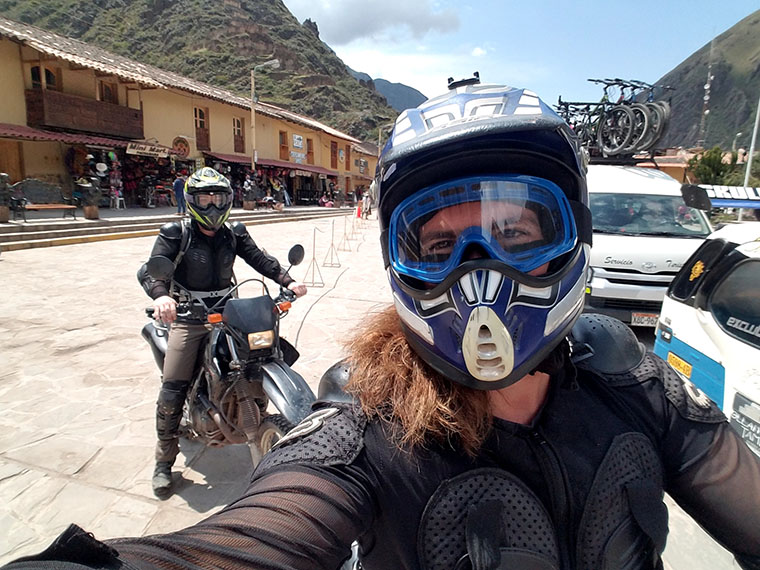
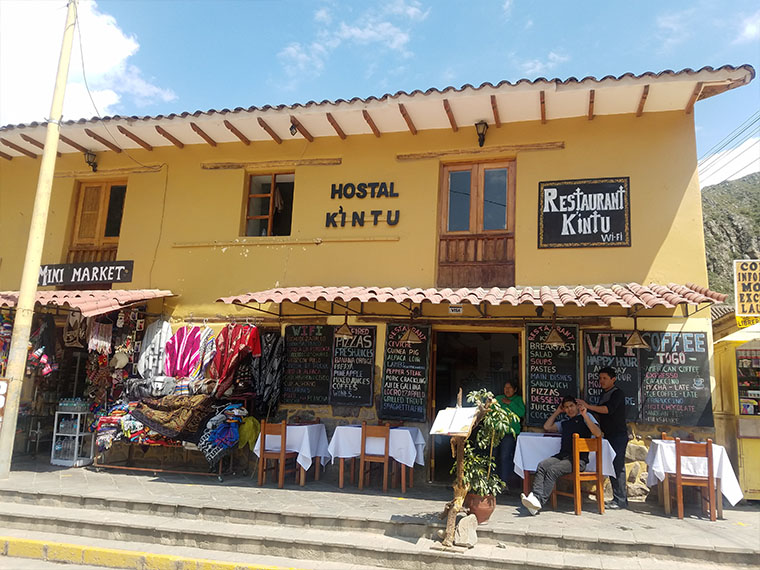
The next leg of your journey from Ollantaytambo to Huayopata District is the most challenging with the most extreme elevation and temperature changes and the sharpest hairpin turns. You'll pass through the Abra de Malaga viewpoint during this stretch which offers some amazing views on a clear day. Unfortunately, we didn't luck out and have a clear day and we ran into some extreme weather conditions at the crest of the mountain on this stretch. Plus it was FREEZING up there and we were ill prepared with our clothing so we just pushed through it and hoped that the conditions improved, which they eventually did. Remember that on the way there we had no idea what came next, so for all we knew it was going to be these types of conditions for the next 4 hours! But luckily it was only a 90 minute stretch of road.
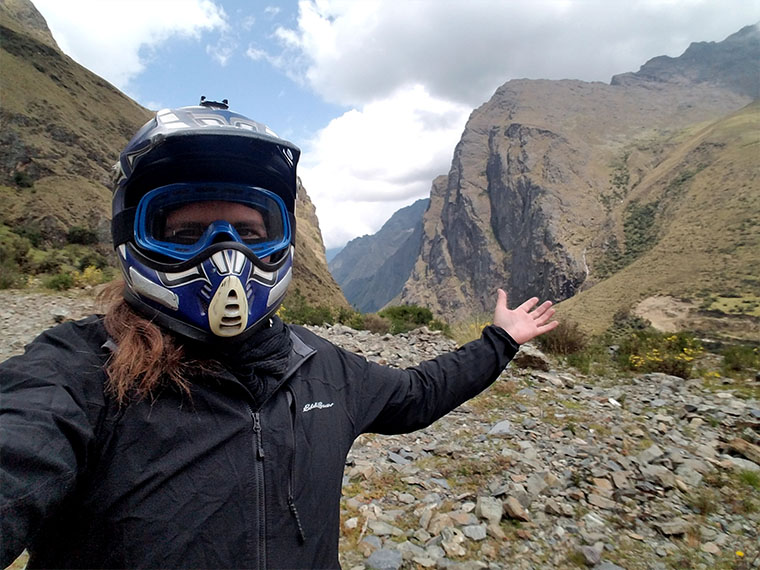
Beyond Huayopata District the elevation drops and the temperature warms up a lot and we were back to t-shirts. The road from Huayopata District to the turn-off for Santa Teresa is smooth sailing and a breath of fresh air after the previous stretch. Eventually you turn left off of the main road onto a dirt road towards Santa Teresa.
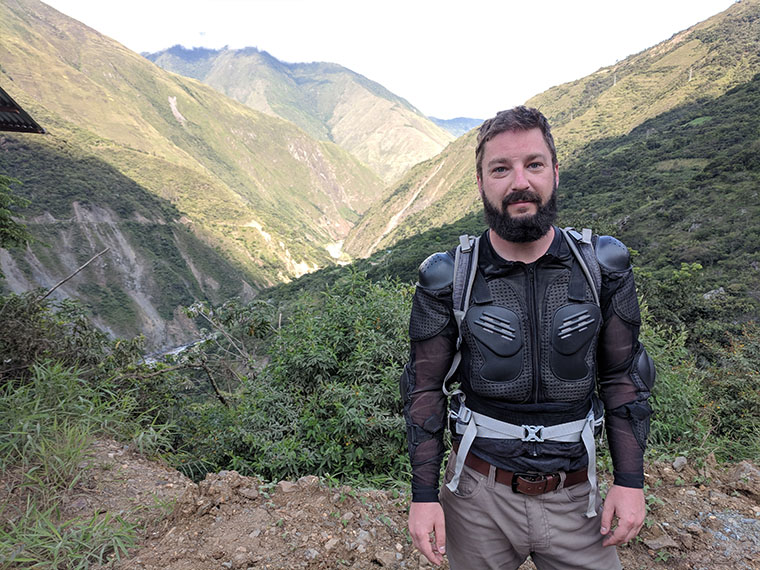
The stretch of dirt road to Santa Teresa is challenging in it's own way but was also one of my favorite parts of the trip. The road follows the Urubamba River for 23 kilometers and offers some of the most spectacular views of the journey. It was this part that Kris said, “I thought I'd only see things like this in my life on TV.” This section of road is truly what travel shows are made of.
This is also the part that I crashed my bike on the way back because the ground was so wet and I was riding through pure mud for a while. And it was also the same part of the trip where the road was closed for reconstruction and we had to ride through a mud path to reconnect. Luckily the bridge was open or else I'm not sure what we would have done. That would've been disappointing to make it all that way and then not be able to cross a river, but knowing me and Kris we probably would've found a way.

Santa Teresa is a simple town located right off the river. Many tourists spend the night to enjoy their thermal baths, but we were on a timeframe so we passed through it quickly, only stopping to pick up some snacks for the upcoming hike.
Step 5: Santa Teresa to Hydroelectrica
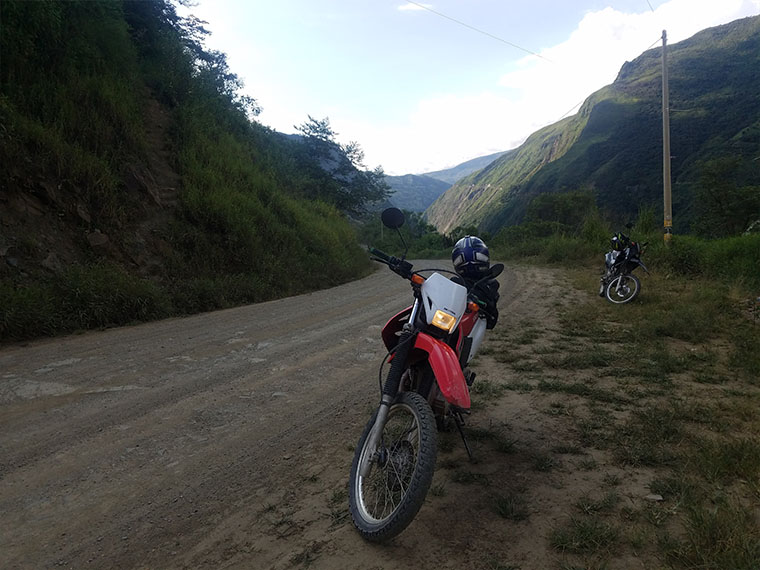
It's a straight shot from Santa Teresa to Hydroelectrica on a dirt road. The road wasn't any better or worse than the dirt road to Santa Teresa, but at this point we were pros, and we reached Hydroelectrica relatively quickly. It's here that the road ends (literally ends) right before the train station.
Step 6: Park your bikes in Hydroelectrica
About 2 minutes before you reach the end of the road, you can turn left over a bridge to reach the home of Señores Eliseo y Wilfredo Escobar where you can securely park your bikes and store your gear for the night. We chatted for a while with Eliseo and learned that his family has built quite the business storing motorcycles for tourists. Kris and I paid 10 soles (about $3.50) each to keep our bikes there for the night. Eliseo was even helpful in getting mine to start the next day when I had issues. Here's a flier he gave me with directions to his place.
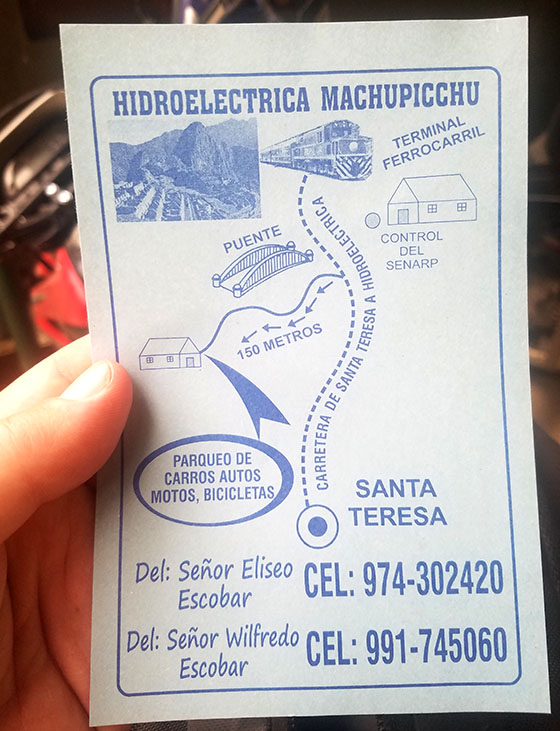
It's hard to miss, and even if you were to drive past it and reach the end of the road, you've only gone past it by two minutes and the people at the welcome center will tell you how to get there.
Step 7: Hike from Hydroelectrica to Agua Calientes
When we arrived at Hydroelectrica, I thought it might be difficult to find the trail. From what I had read online, I thought it was some secret route, but at this point it's far from secret and pretty well known. There's even a government welcome center where you sign in so that they know who's on the route.
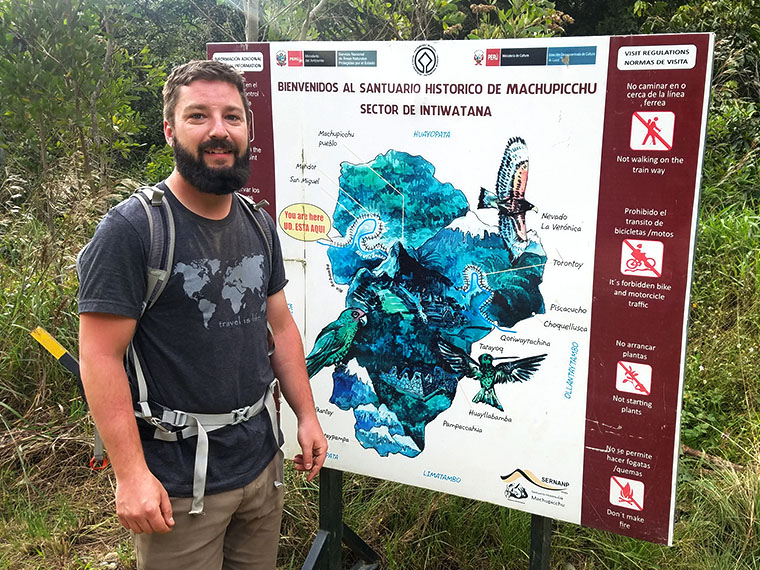
There's a train station at Hydroelectrica but it's not for tourists. It's a local line for Peruvians to come and go from Hydroelectrica. However, if they have enough room on the train after all the locals have gotten their significantly cheaper tickets, they will sell the remaining tickets to tourists for $33.
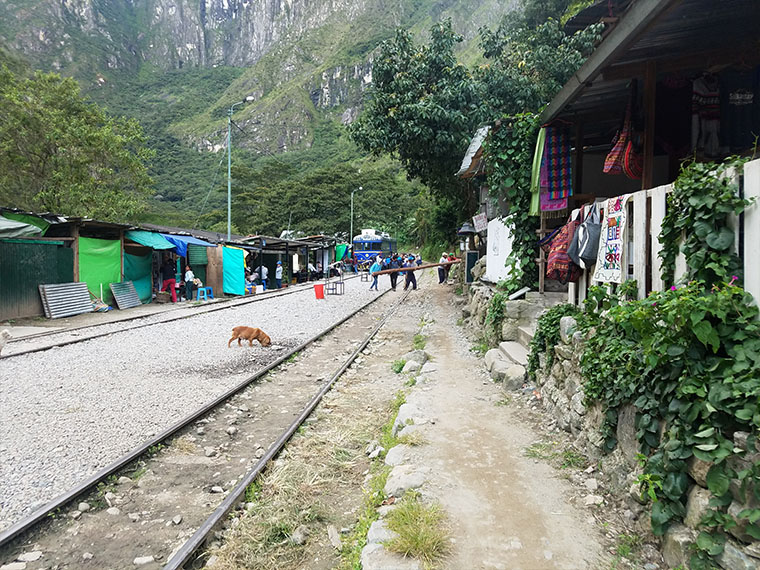
We had the option to buy train tickets, but we had already come so far and didn't feel like spending so much money on an 11km train ride, so we hiked instead, unlike these pussies.
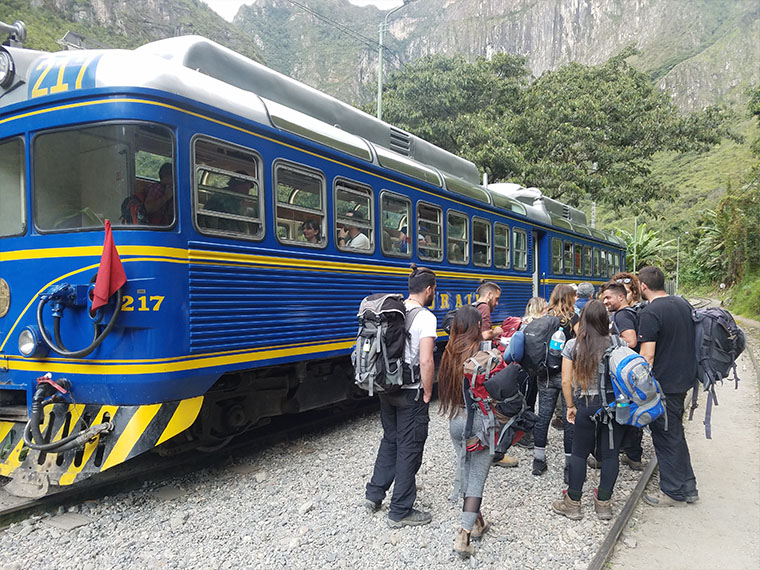
At this point it was almost 5pm and we were losing sunlight fast. It was a little late to get started on a 2 1/2 hour hike, but we were so close to the finish line so we pushed onward. The final 45 minute stretch of our hike was in complete darkness but we both had flashlights and it's a relatively flat and easy hike alongside train tracks, so the darkness wasn't a problem. Here's Kris when we first started the hike breaking the #1 RULE and walking on the train tracks.
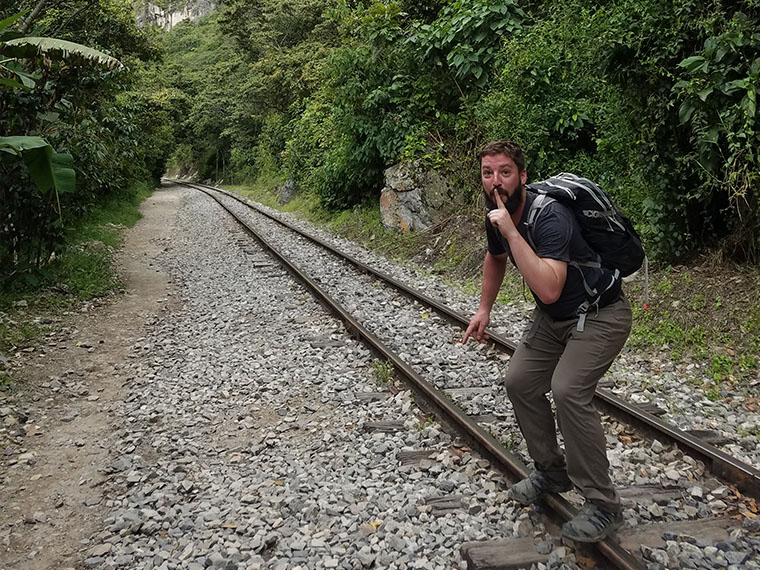
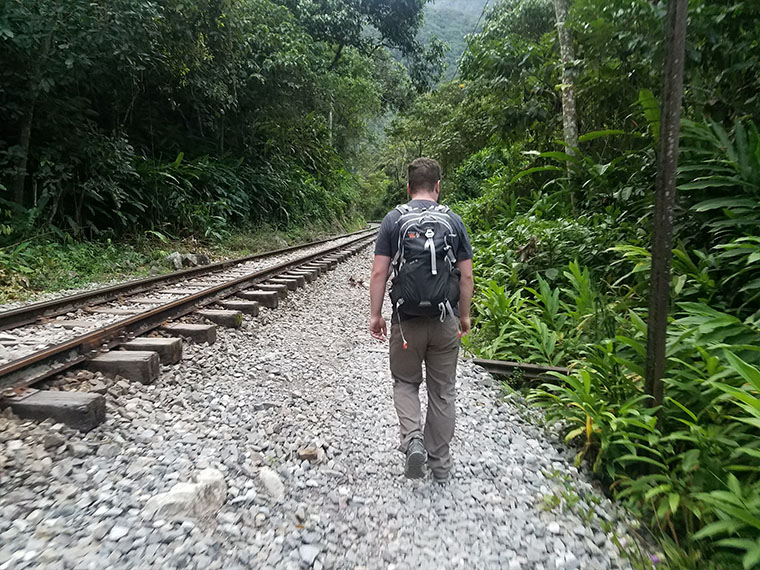
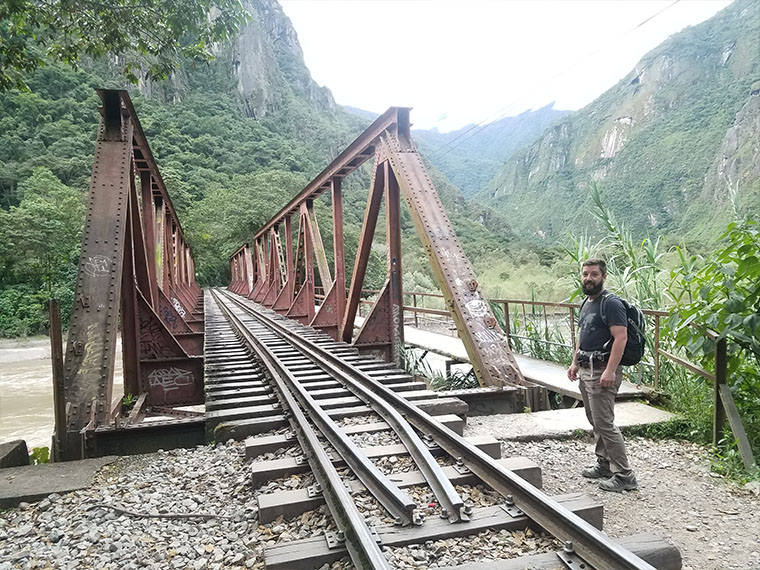
I don't know what I was expecting beforehand… perhaps hiking alongside train tracks through the middle of nowhere and not a person in sight – but it was the exact opposite. All along the route there were houses, hostels, restaurants, and people selling food and drinks along the side of the tracks. And we must've passed several hundred people along the way walking in the opposite direction and returning to Hydroelectrica.
We didn't realize this at the time because it was pitch dark, but we passed Machu Picchu along the way and you can see some of the ruins from the hike. Not a moment too soon, we finally saw city lights in the distance and we reached the town of Aguas Calientes.
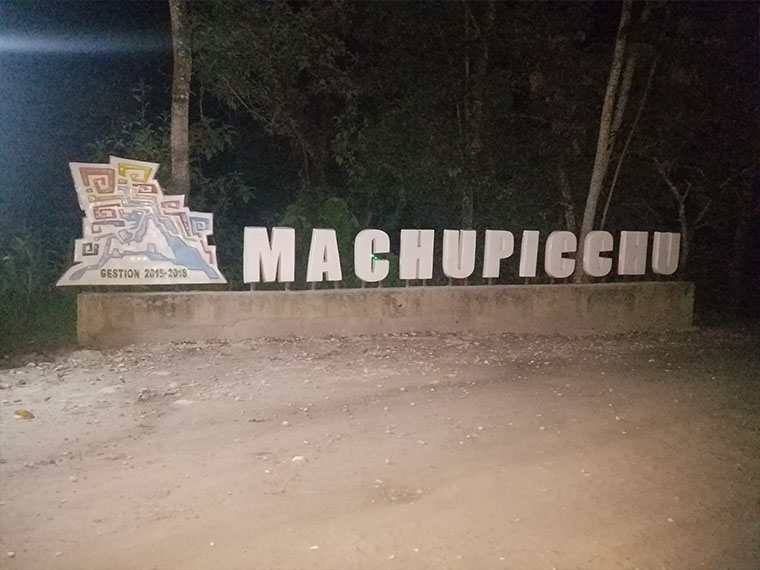
Step 8: Spend the night in Aguas Calientes
There are more than enough hostels and hotels in Aguas Calientes to accommodate the thousands of tourists that pass through each day, but the cheaper ones often fill up fast so you'll probably want to book your room ahead of time. Kris and I, of course, had not booked a room ahead of time, but found a few affordable places. We stayed at the Hostal Samananchis for $40/night for a double room with private bathroom, hot water, Wifi, and breakfast included. I remember taking the most enjoyable shower of my life that night and thinking to myself, “I would've paid twice as much just for this shower.”
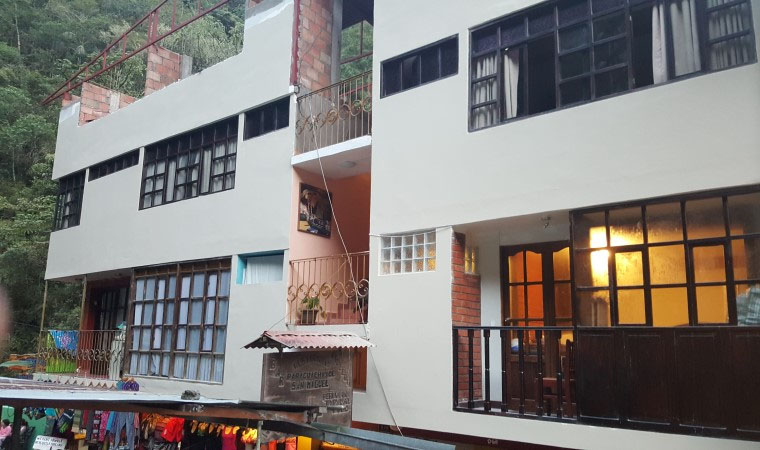
We lucked out finding this place available, but knowing what I know now, I'd make the same decision and stay there again.
Step 9: Buy entrance tickets to Machu Picchu
Not only did Kris and I not have a room in Aguas Calientes before we arrived, we also didn't have tickets to Machu Picchu! But the reality is that there are plenty of tickets available just to Machu Picchu ($70), even the night beforehand. The tickets that sell out weeks or months in advance are to Machu Picchu + Huayna Picchu ($86), Machu Picchu + Mountain ($86), and Machu Picchu + Manuel Chávez Ballón Museum ($77). We chose not to buy our tickets ahead of time because they were already sold out of Huayna Picchu tickets online and we thought there was a small chance we could still obtain two in person – but we were wrong.
So the night we arrived in Aguas Calientes, we found the local office and bought our tickets to Machu Picchu for the next day. It's located at the Ministry of Culture at Ave Pachacutec, Aguas Calientes, Peru.
NOTE: You can buy your tickets online at their official website but the website isn't very mobile friendly and still uses Flash because it's like a million years old, so you'll want to do so from a desktop browser.
Machu Picchu tourism operates in two shifts from 6am to 12pm and from 12pm to 5:30pm, and you choose which shift you want to visit when you buy your ticket. You can show up anytime you want during that window and your entrance fee entitles you to the ruins for 4 hours. We chose the early shift because we also had to hike back to Hydroelectrica and ride our moto bikes to Santa Teresa that same day. Plus everything I read about Machu Picchu said that the early shift was better and that it was best to arrive as early as possible to avoid the crowds – which now that I've been I fully agree with. We were SO happy that we arrived early and got some great photo opportunities before the mad rush of tourists arrived.
Step 10: Buy bus tickets to Machu Picchu
From Aguas Calientes, you can either take a 25 minute bus up the mountain to Machu Picchu or you can hike straight up the mountain for 90 minutes. Some people choose to take the bus up and hike down but we opted to take the bus in both directions because we were on a timeframe. The bus tickets are about $25 each for round trip and leave every 15 minutes. You don't buy tickets for a particular time, you just buy your tickets and arrive at the station the next morning and leave on the next available bus.
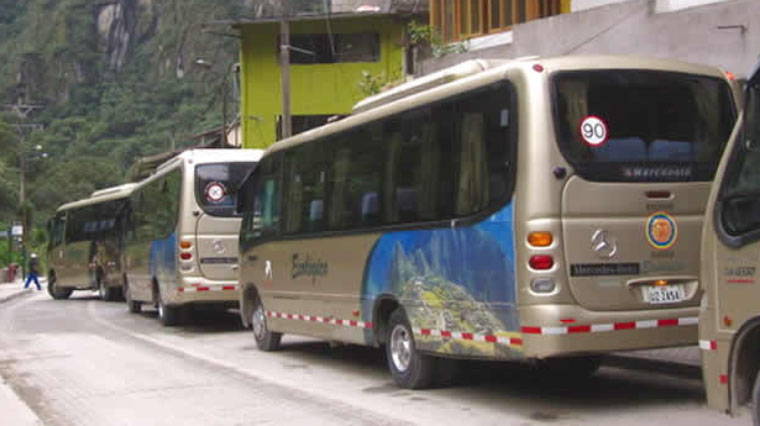
You buy your bus tickets at the tiny stand located at here. There's not really an address for it so I just linked to the exact spot on Google Maps.
Step 11: Take the bus from Aguas Calientes to Machu Picchu
We were anticipating a long line at the bus station the next morning, but they've got this down pat at this point. We didn't even wait 60 seconds to board the bus and there was another one right behind it ready to go for the next set of tourists after us. The ride took about 25 minutes.
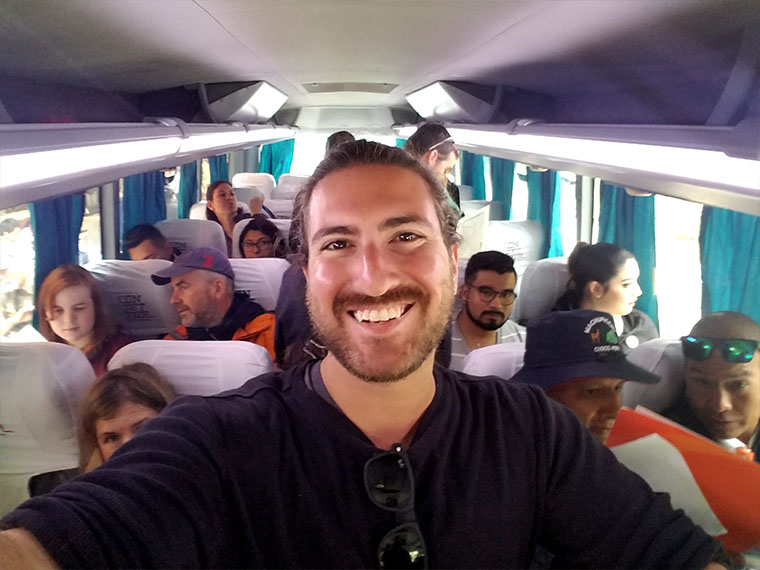
We left our bookbags behind at the hotel so that we didn't have to carry our stuff around the whole day, and it was a smart decision. I recommend you do the same. Every hotel / hostel in that town offers the service to store your stuff for the day, even though checkout time is early in that town.
Step 12: Visit Machu Picchu!
We made it! All our hard work paid off and we earned the prize at the end of the journey. If you haven't already booked a tour by the time you get there, there are lots of tour guides waiting outside Machu Picchu who you can hire for about $20-30 for a group tour. If you're there solo or in a couple, team up with another group and you can split the cost of the tour amongst everyone.
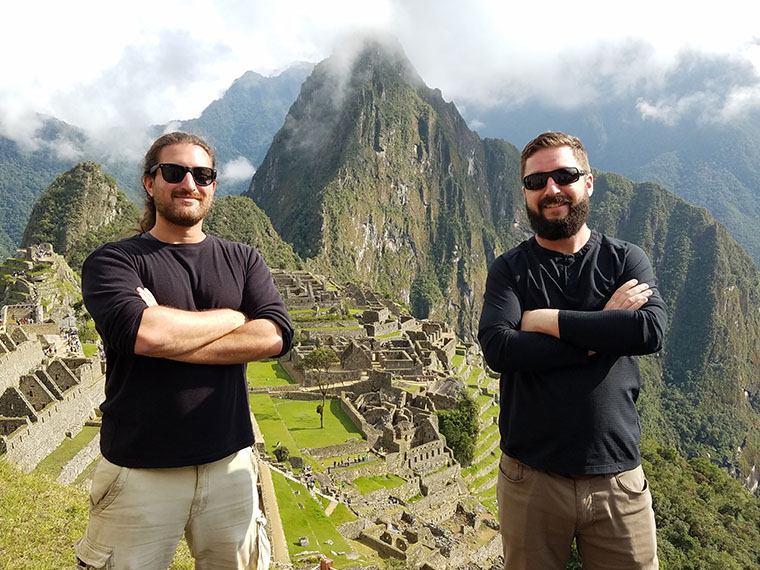
People spend thousands of dollars, travel thousands of miles, and take days out of their lives to visit Machu Picchu. And the question I had on my mind for everyone was… Is Machu Picchu worth it? I asked several tourists and here's what they told me.
Step 13: Hike back to Hydroelectrica
When we had our fair share of Machu Picchu and it was starting to get late, we took a bus back down to Aguas Caliente, grabbed our bags from the hotel, and began our hike back to Hydroelectrica. This time it was the middle of the day so we got to see the part of the hike that we couldn't see the night before because it was so dark. It was then that we realized you can see part of the ruins from the hike.
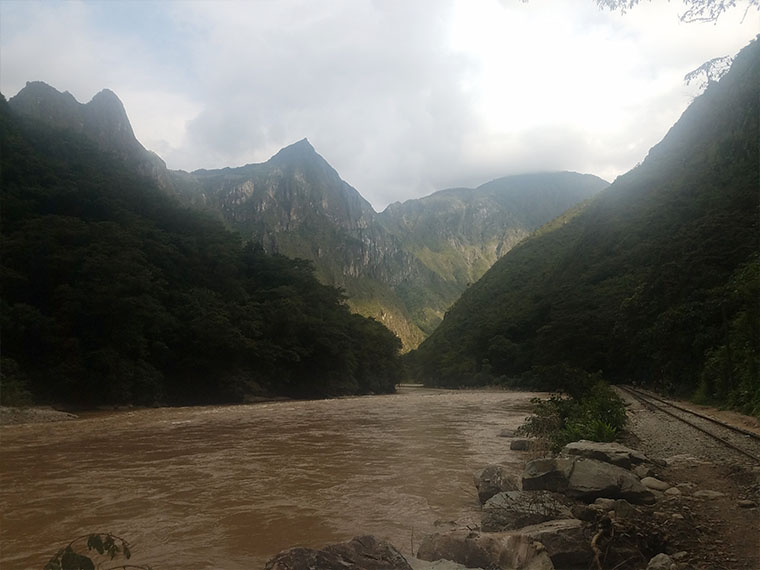
Step 14: Get your bikes
We met back up with Eliseo y Wilfredo and got our bikes back. They're both super nice guys and I told them that I would write about their business in this post so that other people would know how easy and safe it was to store our bikes for the night. Plus it's kind of your only option, unless you were to store your bikes in Santa Teresa for the night and catch a ride to Hydroelectrica from there. But there's really no need to as Eliseo y Wilfredo only charge 10 soles.
Step 15: Ride to Santa Teresa and spend the night
From there we rode the 45 minutes to Santa Teresa to spend the night. We considered continuing onward and cutting out part of the journey for the next morning, but since we weren't about to tackle that horrible mountain at night, we decided to just rest up in Santa Teresa since it was the best place to stay in between Hydroelectrica and the mountain. I forgot the name of the hotel we stayed at in Santa Teresa, or maybe I never knew, but it doesn't really matter. It was nothing to write home about. There is plenty of available cheap accomodation in Santa Teresa to get you by for a night. We thought about going to the thermal baths, but ended up having a great big dinner instead and passing out early.
Step 16: Ride Santa Teresa to Cusco
This time we took the other route through Pisac. Due to the problems I had with my bike and the wreck, it took a lot longer to get back than it did to arrive, so we didn't arrive in Cusco until about 8pm which meant the final stretch of our journey was in the dark and through city traffic in Cusco. Although I loved the ride and the whole adventure, I was exhausted and I couldn't have been happier to return my bike to Juan Carlos and be off of a motorcycle!
In Conclusion + What I'd Do Different
I highly recommend riding motorcycles to Machu Picchu because it was one of the greatest rides of my life and an amazing adventure. However, I need to caveat again that you should be a relatively experienced rider to do this one. I feel required to add that caveat because I don't want anyone's death on my hands and in reality, there were many potential scenarios on that route where an inexperienced or even an experienced rider could meet their fate.
Here are just a few things I'd do differently in hindsight:
Overall this was an amazing adventure and I think the best way to get to Machu Picchu! I hope this article helps you plan your ride. Please share it with your friends or link to it on your blog if you'd like to share this adventure for others to have as well. And if you have any questions, feel free to ask below in the comments. Safe travels!
And lastly, if you enjoyed reading about this adventure and watching my videos, follow along with Travel is Life on Facebook at https://facebook.com/travelislifeorg.
Watch & share the video trailer to this post on Facebook
If you like it then you should've put a Pin on it!
Love this post and want to share it to your favorite travel boards? Use my special Pinterest friendly graphics below.
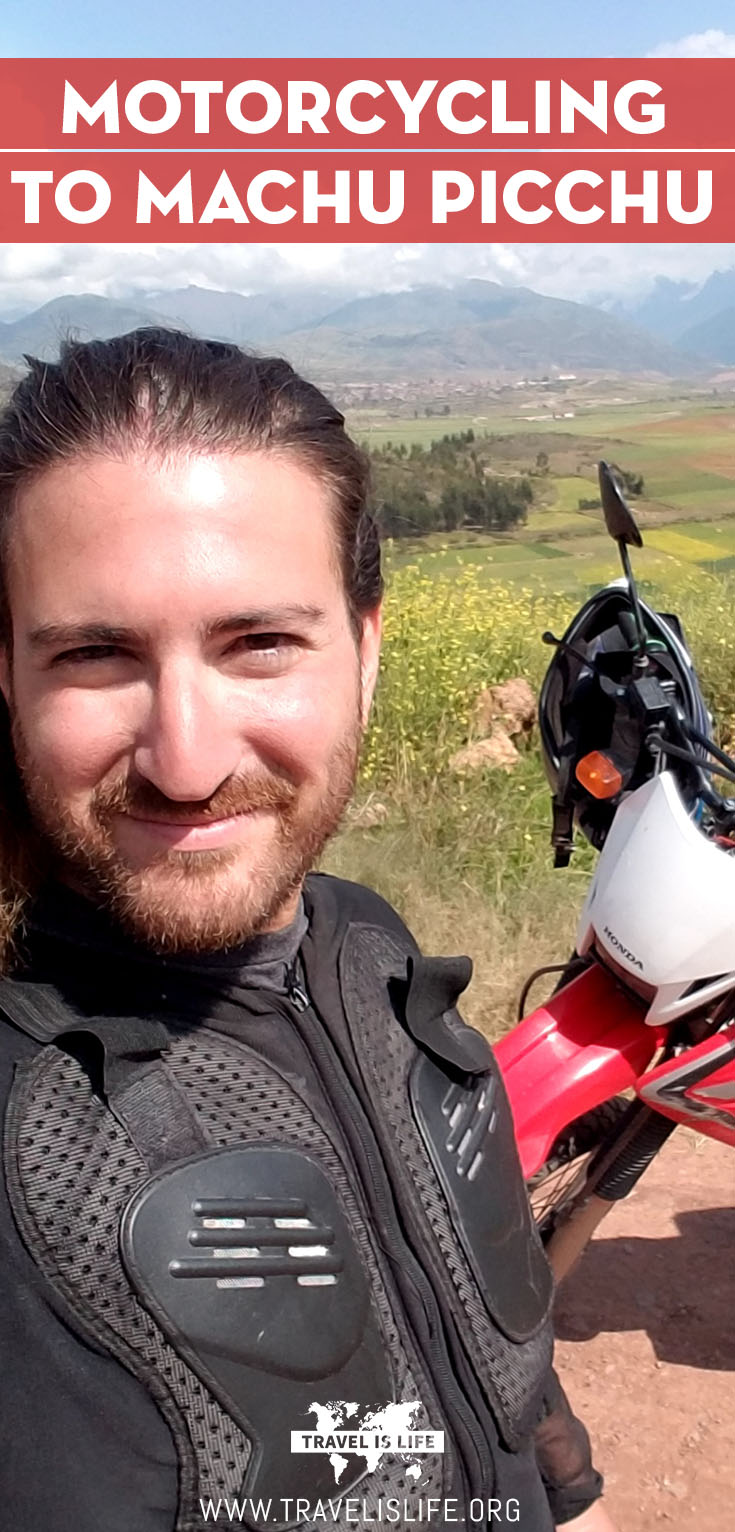
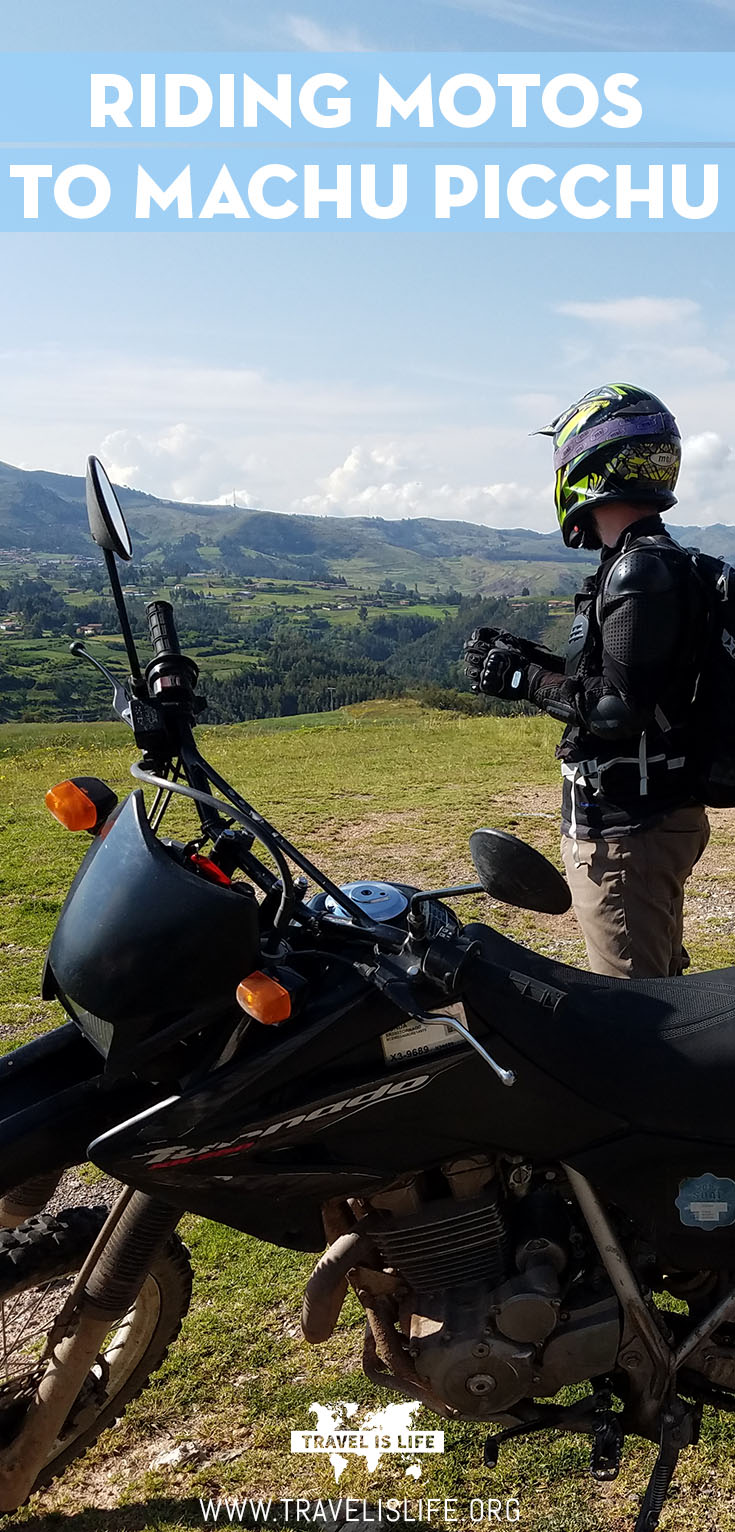
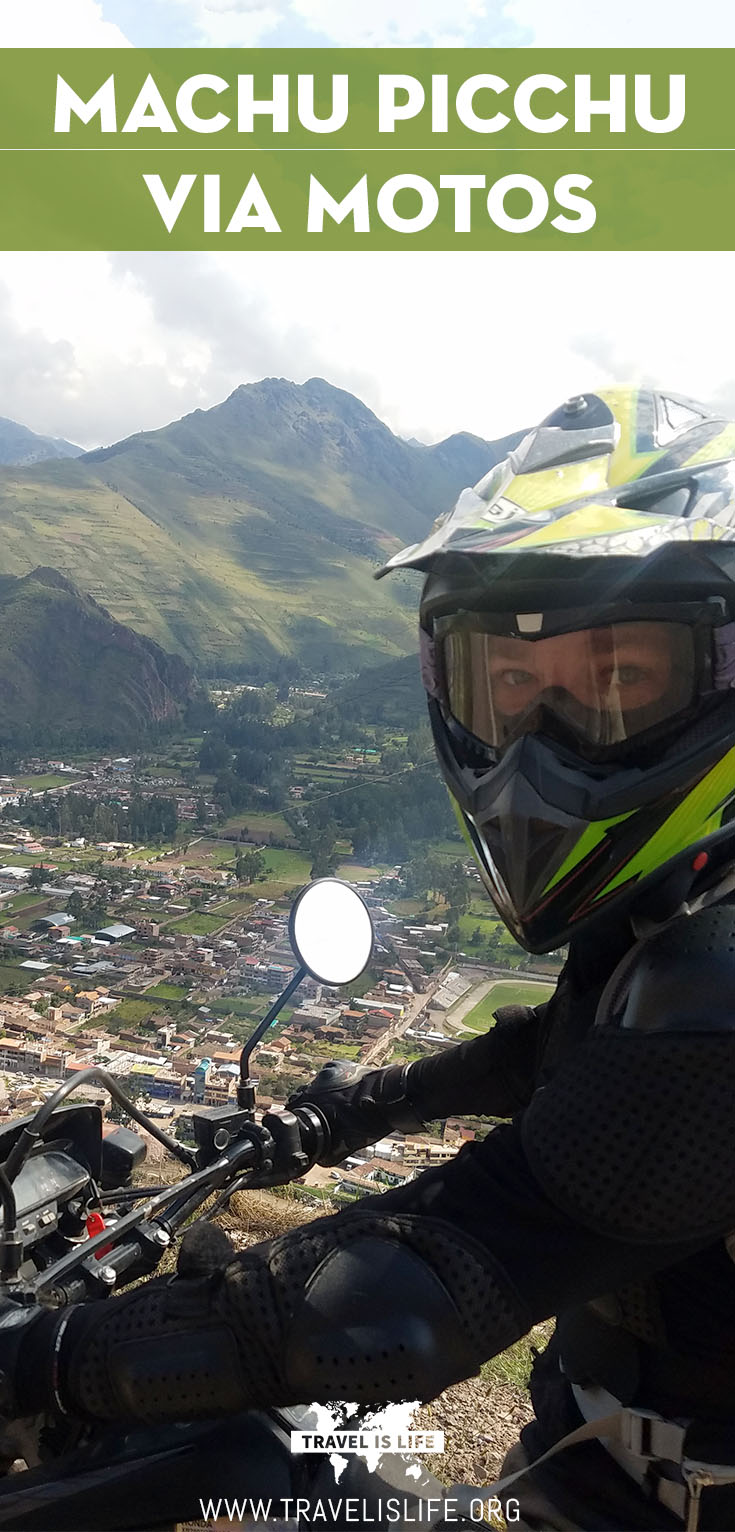

Awesome awesome awesome. I’ll be there on 24th February 2019, doing a 3 or 4 day moto tour. Looking forward to this
You’ll love it! Ride safe, Brad. Enjoy.
Planning a trip here soon! Had no idea you could get there this way! Also, love the helicopter idea !! Someone needs to start that business. Huge fan of the blog, thanks for the inspiration!
Thanks Valentina – I hope you have a great time in Cusco and Machu Picchu. We sure did!